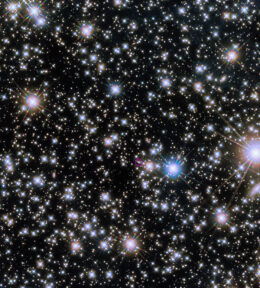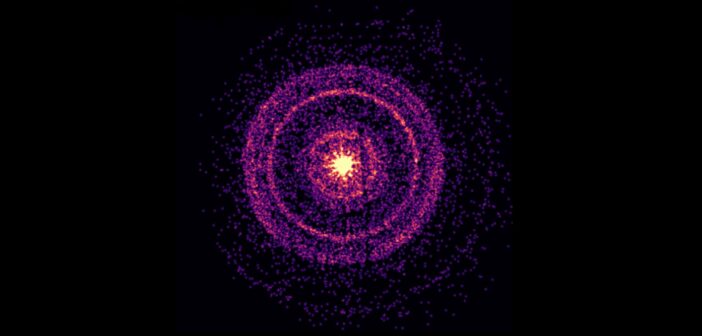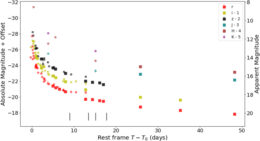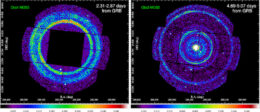Gamma-ray bursts are the most luminous explosions in the universe, and we’ve learned much about these superlative outbursts since their discovery in 1967. A new Focus Issue of the Astrophysical Journal Letters released yesterday showcases results related to the gamma-ray burst GRB 221009A: the brightest of all time. Today’s post briefly introduces the Focus Issue articles that have already been published or are in press — be sure to check out the full articles linked below, and keep an eye out for future articles in this issue!
A Superlative Burst

An infrared image of the afterglow of GRB 221009A (circled), taken 1–2 months after the onset of the burst. The burst’s host galaxy is the faint, extended source behind the burst. Click to enlarge. [NASA, ESA, CSA, STScI, A. Levan (Radboud University); Image Processing: Gladys Kober]
On 9 October 2022, a remarkable new gamma-ray burst named GRB 221009A was picked up by 25 satellites, most of which weren’t designed to detect gamma-ray bursts — like Voyager 1 and a pair of Mars orbiters. The burst even made an impact on Earth’s atmosphere, creating a disturbance as large as a solar flare would. To put that into context, this means that an explosion roughly 2 billion light-years away had as large an effect on our atmosphere as a solar flare more than 100 trillion times closer!
GRB 221009A Across the Electromagnetic Spectrum
An article led by Maia Williams (Pennsylvania State University) describes the initial discovery and the properties of this extremely bright, long-lived burst. GRB 221009A’s X-ray afterglow is more than an order of magnitude brighter than other gamma-ray bursts observed by the Swift Observatory, and analysis of its emission suggests that the jet it produced is extremely narrow. However, the authors found that GRB 221009A’s afterglow emission isn’t fit well by some of our standard models for how the emission is produced — namely, a jet of energetic particles interacting with material surrounding the object — suggesting that further work is needed to understand the event.

Radio, optical, and X-ray observations of GRB 221009A at different times, with the observation day indicated by the symbol color. The solid lines indicate the results of a shock emission model. The model fails to capture the observed radio flux. Click to enlarge. [Laskar et al. 2023]
In addition to space-based gamma-ray telescopes, researchers used a ground-based gamma-ray observatory to study the event. Luckily for life on Earth, most gamma rays fail to reach our planet’s surface, but we can detect the faint light emitted when gamma rays interact with particles in the atmosphere. Researchers used the High Energy Stereoscopic System (HESS) — a set of five telescopes located in Namibia — to search for emission linked to GRB 221009A, but found none. Despite this, the upper limits derived from the observations allowed the HESS team to constrain the possible emission mechanism for the burst.
David Kann (Goethe University Frankfurt) and collaborators presented optical and X-ray data spanning from the prompt phase of the burst out to 60 days post-burst. The team used these observations to study the dust along the path between the burst and Earth, finding that the burst’s host galaxy is probably moderately dusty. Modeling of the burst’s jet presented some curiosities: the simplest jet model failed to reproduce the observations, and adding structure and other features to the jet didn’t improve the fit.
Supernova or No?
In addition to the prompt and afterglow emission, gamma-ray bursts are often accompanied by a supernova, powered by nuclear reactions within the material expelled as the star collapses. As the emission from the burst fades, emission from the supernova brightens, eventually peeking out from beneath the fading afterglow as a bump in the light curve days or weeks after the onset of the burst. One of the many intriguing features of GRB 221009A’s evolution is that it might not show any supernova emission.
Manisha Shrestha (University of Arizona) and collaborators examined GRB 221009A’s light curves and spectra for signs of a supernova, but didn’t find a convincing supernova signal in either. The team’s modeling suggested that a supernova could be hidden beneath the bright afterglow, though, depending on how much the host galaxy’s dust stifles the light from the supernova. Michael Fulton (Queen’s University Belfast) and coauthors monitored the burst at optical wavelengths as it faded over the course of nearly two months, finding a potential but inconclusive supernova bump around 20 days after the burst.Andrew Levan (Radboud University) and collaborators turned two exceptional telescopes toward the burst — JWST and the Hubble Space Telescope — and obtained the first mid-infrared spectrum ever taken of a gamma-ray burst. These observations suggest that if there is a supernova accompanying the burst, it’s faint or its spectrum peaks at wavelengths bluer than those covered by JWST and Hubble. Future work will help to disentangle the emission from the gamma-ray burst afterglow, the possible accompanying supernova, and the gamma-ray burst host galaxy that is visible in the Hubble images. If this burst occurred sans supernova, it might mean that the newly formed black hole swallowed the debris of the exploded star, or it could mean — though the team deems this unlikely — that GRB 221009A was instead caused by the merger of neutron stars.
Polarization, Particles, and Dusty Pathways
A team led by Michela Negro (University of Maryland, Baltimore County) observed the burst with the Imaging X-ray Polarimetry Explorer, obtaining the first measurement of polarized X-rays from a gamma-ray burst afterglow. The observations revealed a bright central core of emission surrounded by rings created by photons scattering off of dust grains. In other words, the team was able to study the prompt emission (in echo form) and the afterglow simultaneously! The team placed an upper limit on the polarization fraction of 13.8% for the afterglow emission and somewhere between 55% and 82% for the prompt emission.

Electron flux measured by one of the three detectors making up the High-Energy Particle Package (black) and the scaled photon count from the High Energy Burst Searcher (blue). Click to enlarge. [Battison et al. 2023]
The IceCube Collaboration also searched for particles associated with the burst, but neutrinos — chargeless, nearly massless particles produced in a variety of high-energy astronomical phenomena — proved elusive. The link between neutrinos and gamma-ray bursts is theorized but yet to be proven, and the team detected no neutrinos from the event. Planned upgrades to the IceCube Neutrino Observatory might allow us to detect neutrinos, if present, from future gamma-ray bursts.
To reach us on Earth, emission from GRB 221009A had to carve a path through the Milky Way. As the narrow beam of emission pierced our galaxy, it illuminated dust clouds along its path like the beam of a flashlight. Because of this, researchers observed shifting rings of X-ray emission for weeks after the event, showing where X-rays had scattered off of dust clouds within the Milky Way. Andrea Tiengo (IUSS – School for Advanced Studies and National Institute of Astrophysics, Italy) and collaborators reported the detection of 20 such rings, corresponding to echoes off dust clouds located 1,000–61,000 light-years from Earth.Brightest of All Time… So Far
Since its discovery, GRB 221009A has been referred to as the BOAT — the Brightest Of All Time. In the final Focus Issue article published yesterday, Eric Burns (Louisiana State University) and collaborators explored whether that moniker is truly deserved. By comparing against decades of gamma-ray burst observations, the team found that GRB 221009A indeed had by far the highest peak flux of any gamma-ray burst measured to date, and it topped the list for two out of the remaining three measures of brightness. Looking more closely at the properties of events observed over the past 50 years, the team estimated that GRB 221009A is a once-in-ten-millennia event. So while GRB 221009A is certainly not the brightest gamma-ray burst in the history and future of the universe, it’s probably the brightest burst in the history of human civilization — and its rarity means we’re lucky it happened while we have working gamma-ray telescopes!
Over the past few months, GRB 221009A has been hidden from view, blocked by the Sun’s disk. Soon, though, its reemergence will give researchers the chance to study it further and hopefully solve some of the lingering mysteries about its evolution.
Bonus
In addition to the Focus Issue articles published yesterday and those still to come, you can watch a recording of the GRB 221009A press conference presented yesterday at the 20th meeting of the High Energy Astrophysics Division.
Citation
Articles belonging to the Focus Issue will be collected here: Focus on the Ultra-luminous GRB 221009A


